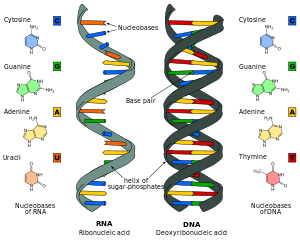
Back نظير الحمض النووي Arabic Anàleg d'àcid nucleic Catalan Análogos de ácidos nucleicos Spanish Analogue d'acide nucléique French תחליפי חומצות אמינו HE Analogne nukleinske kiseline Croatian 핵산 유사체 Korean Аналоги нуклеиновых кислот Russian Analogna nukleinska kiselina Serbo-Croatian Analogna nukleinska kiselina Serbian

Nucleic acid analogues are compounds which are analogous (structurally similar) to naturally occurring RNA and DNA, used in medicine and in molecular biology research. Nucleic acids are chains of nucleotides, which are composed of three parts: a phosphate backbone, a pentose sugar, either ribose or deoxyribose, and one of four nucleobases. An analogue may have any of these altered.[1] Typically the analogue nucleobases confer, among other things, different base pairing and base stacking properties. Examples include universal bases, which can pair with all four canonical bases, and phosphate-sugar backbone analogues such as PNA, which affect the properties of the chain (PNA can even form a triple helix).[2] Nucleic acid analogues are also called xeno nucleic acids and represent one of the main pillars of xenobiology, the design of new-to-nature forms of life based on alternative biochemistries.
Artificial nucleic acids include peptide nucleic acids (PNA), Morpholino and locked nucleic acids (LNA), as well as glycol nucleic acids (GNA), threose nucleic acids (TNA) and hexitol nucleic acids (HNA). Each of these is distinguished from naturally occurring DNA or RNA by changes to the backbone of the molecule. However, the polyelectrolyte theory of the gene proposes that a genetic molecule require a charged backbone to function.
In May 2014, researchers announced that they had successfully introduced two new artificial nucleotides into bacterial DNA, and by including individual artificial nucleotides in the culture media, were able to passage the bacteria 24 times; they did not create mRNA or proteins able to use the artificial nucleotides. The artificial nucleotides featured 2 fused aromatic rings.
- ^ Singer E (July 19, 2015). "Chemists Invent New Letters for Nature's Genetic Alphabet". Wired. Retrieved July 20, 2015.
- ^ Petersson B, Nielsen BB, Rasmussen H, Larsen IK, Gajhede M, Nielsen PE, Kastrup JS (February 2005). "Crystal structure of a partly self-complementary peptide nucleic acid (PNA) oligomer showing a duplex-triplex network". Journal of the American Chemical Society. 127 (5): 1424–30. doi:10.1021/ja0458726. PMID 15686374.
© MMXXIII Rich X Search. We shall prevail. All rights reserved. Rich X Search